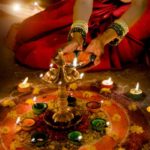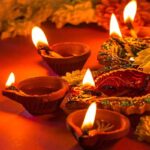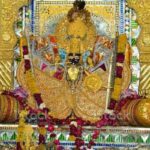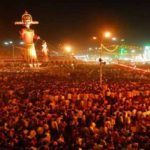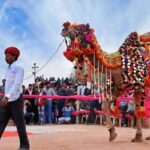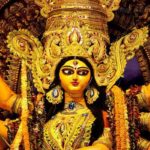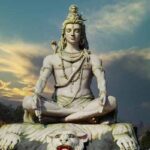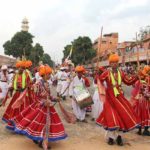Diwali Celebration in India The Festival of Lights, Deepawali or Diwali, symbolises the triumph of justice and the lifting of spiritual gloom. Literally the term ‘Deepawali‘ means rows of diyas (lay lamps). This is one of the Hindu calendar’s most celebrated festivals. On the 15th day of Kartika (October / November), it is celebrated. This festival commemorates the return of Lord Rama to his Ayodhya kingdom After he ended his 14-year exile.
Diwali is a celebration of the lights, the most beautiful of all Indian festivals. Rows of clay lamps illuminate the streets and houses are adorned with colours and candles. This festival is celebrated in the company of family and friends, with new clothing, dazzling firecrackers and a range of sweets All this enlightenment and fireworks, joy and celebration, represent the triumph of the holy powers over the wicked.
Often worshipped on this day is the Goddess Lakshmi (consort of Vishnu), who is the symbol of riches and prosperity. This festival is celebrated in West Bengal as Kali Puja, and on the occasion of Diwali, Kali, Shiva’s consort, is adored.
The festival of Deepawali also commemorates the conquest of Asura Naraka in the South, a powerful king of Assam who imprisoned thousands of inhabitants. It was Krishna who eventually managed to subdue Naraka and set the prisoners free. To commemorate this occurrence, people in Peninsular India wake up before sunrise, mixing kumkum or vermillion with oil to produce imitation blood. After crushing a bitter fruit underfoot as a demon sign, the ‘blood‘ is triumphantly added to their foreheads. They have ceremonial oil baths then, anointing themselves with paste of sandalwood. Wide family breakfasts of fruit and a choice of sweets are accompanied by visits to temples for prayers.
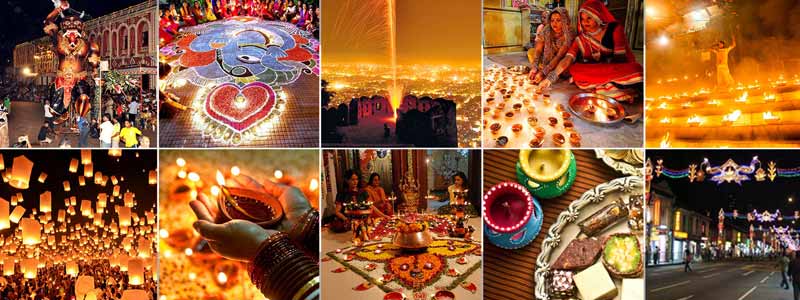
Another storey about King Bali is related to the festival of Diwali in South India. King Bali was, according to Hindu mythology, a benevolent demon king. He was so powerful that the influence of celestial deities and their kingdoms became a threat. And Lord Vishnu came to dilute Bali ‘s strength, like the dwarf mendicant Vamana. As he marched, Vamana shrewdly asked the king for land that would cover three levels. The king gladly bestowed this gift. Vishnu showed himself in the absolute glory of his godhood, having fooled Bali. In his first move he enclosed the heaven, and in his second, the earth. Bali surrendered, realising that he was pitted against the mighty Vishnu, and offered his own head, inviting Vishnu to step on it. Vishnu pushed him with his foot into the nether realm. In return Vishnu gave him the lamp of wisdom to illuminate the dark subworld. He also gave him the blessing that he would return to his people once a year to light millions of lamps from this one lamp, so that the blinding darkness of ignorance, envy , jealousy, desire, rage, vanity, and laziness would be dissipated from the dark new moon light of Diwali, and the radiance of wisdom would be dissipated, Friendship and wisdom will prevail. Every year on Diwali Day, even today, one lamp lights another and carries a message of peace and harmony to the world, like a flame that burns steadily on a windless night.
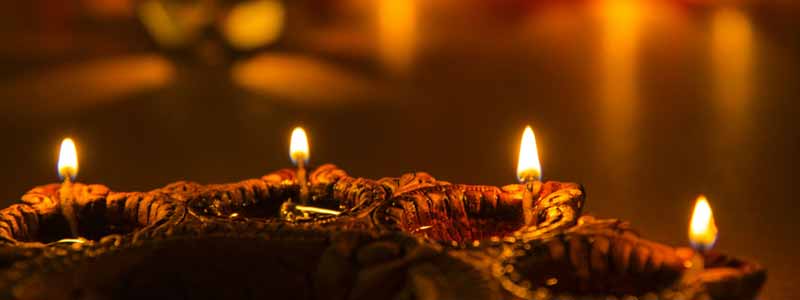
History and Rituals behind the Celebration of Diwali Festival
The Lights’ Festival, i.e. Diwali, according to the Hindu lunar calendar, is traditionally observed at full moon light, sometime in the month of Ashwin and Kartika (October or November). The legend, however, says that when Lord Rama (King of Ayodhya) defeated Ravana (demon king of Lanka), the people of Ayodhya draped the entire kingdom with diyas to celebrate the return of Rama. For this very reason, the Diyas have been an important part of the Festival of Diwali. In addition, Goddess Lakshmi is regarded as the Goddess of riches on this auspicious day, and Deity Ganesh, the Deity of knowledge and learning, is venerated in the coming year to bring good luck and prosperity. People want each other to distribute sweets after the ‘puja’ ceremony is done, Seek blessings from the older members of the family, appreciate crackers bursting and appreciate a lip-smack dinner together.
Dhanteras festival marks the start of Indian Diwali festival. It is a day when people are involved in cleaning up their homes and premises. On this day, special prayers are offered for the birthdays of Goddess Lakshmi and Dhanvantari-known as the Goddess of riches and prosperity.
The Five Days of Diwali
Diwali is a festival lasting five days that straddles the new moon. While widely celebrated across India, in some parts of India the days may have distinct names and additional meanings, there is enough commonality to define each day briefly:
Dhanteras
Dhanteras marks the start of five-day Diwali festivities. It is customary for people to clean their homes on this day, so they are ready to receive Lakshmi, the Goddess of Riches and Prosperity, whose evening puja is being performed. Today is an auspicious day and a fortunate day to purchase luxury things, but charity for those less well off is also a day to consider. Small clay lamps, called diyas are lit to drive away the shadows of evil spirits.
Naraka Chaturdashi
According to Hindu tradition on the second day Lord Krishna destroyed the demon Narakasura. In some regions of India, customs on this day are about cleaning the slate before the start of a new year and getting rid of something evil, marking the coming end of the year. People get up and shower early and put on clean clothes or new ones. This day is celebrated in parts of Southern India as the main day of Deepavali.
Diwali
The third day is celebrated in Kartik on the New Moon. This is the festival’s most popular day in most parts of India, and is the last day of the year in many regions of India. Lord Rama rescued his child, Sita, from the demon Ravana on this day, and returned home after a long exile. Candles are lit to celebrate his victory, after the battle, and to light his way home. In the evening, it may seem like the whole of India is lit by explosions as people set off many fireworks.
Balipadyami
The fourth day of Diwali in the Vikram Samvat calendar is also the first day of the new year and may also be known as Pratipada, Govardhan Puja or Annakut. Annakut means ‘food mountain,’ which is a giveaway that’s all about feasting today. Tradition has it that Lord Krishna raised Govardhan Hill on this day to provide shelter to local villagers from the torrential rains. Hindus are cooking a great deal of food today and taking it to the temples to celebrate the start of the new year and to thank Krishna for his benevolence.
Bhai Bij
This is the 5th and last day of the Festival of Diwali. The bond between brother and sister is celebrated on this day. Learn more about Bhai Bij.
Following Diwali lights and stories across India
Diwali festivities and rituals take on fascinating manifestations as you traverse the country. Each area focuses on a specific mythological occurrence or perception of it, with celebrations devoted to various deities.
Diwali in North India
Diwali ‘s Indian Festival is one of the most awaited and widely acclaimed festivals. And in a country so diverse, in various ways across the nation, Diwali celebrations find resonance and retelling. Popular traditions mark it as the day the devil, Ravana, was defeated by Lord Ram and returned to his home town, Ayodhya. Instead, Southern India names it Deepavali, and celebrates the day Lord Krishna killed Narakasura the demon. Diwali or Deepavali is a time of joy and togetherness all over the world , regardless of which mythological camp you fall into.
In various religions and regions of India, the festival of light is celebrated. The Hindus believe Diwali is when Lakshmi, the Hindu prosperity goddess, blesses her people with riches and happiness. The Jains observe the festival to mark the day when Nirvana was achieved by Lord Mahavira, the last of the 24 Tirthankaras. The Sikhs celebrate the festival as a reminder of their teacher, Guru Hargobind Ji, who on this day was released from Gwalior’s Mughal captivity.
Diwali ‘s Indian Festival is one of the most awaited and widely acclaimed festivals. And in a country so diverse, in various ways across the nation, Diwali celebrations find resonance and retelling. Popular traditions mark it as the day the devil, Ravana, was defeated by Lord Ram and returned to his home town, Ayodhya. Instead, southern parts of India call it Deepavali and celebrate the day Lord Krishna killed Narakasura the demon. Diwali or Deepavali is a time of joy and togetherness all over the world , regardless of which mythological camp you fall into.
In various religions and regions of India, the festival of light is celebrated. Diwali is believed by the Hindus as Lakshmi, the Hindu Prosperity Goddess, blesses her people with riches and happiness. The Jains observe the festival to mark the day when Nirvana was achieved by Lord Mahavira, the last of the 24 Tirthankaras. The Sikhs celebrate the festival as a reminder of their teacher, Guru Hargobind Ji, who on this day was released from Gwalior’s Mughal captivity.
The everlasting fight between good vs. evil. Diwali celebrations in North India continue for five days once it is time for the actual festival, starting with ‘Dhanteras‘ and extending until ‘Bhai Dooj.’
Diwali festivities revolve around Lord Rama in the northern part of India, and his victory over Ravana. Lord Rama went into exile for fourteen years, during which his queen, Sita, was abducted by the ten-headed demon Ravana. Lord Rama fought an epic war against Ravana along with his brother Laxman and beloved devotee Lord Hanuman, and rescued Sita. Lord Rama was greeted by a village fully lit up with lamps to illuminate his journey upon returning to Ayodhya.
Diwali begins with ‘Dhanteras‘ in North India, which is two days before the actual festival. It’s a day when people buy utensils from gold , silver, or copper, as it’s deemed propitious. ‘Chhoti Diwali’ is accompanied by Dhanteras, which eventually culminates in Diwali and its great celebrations.
The houses are adorned with afternoons, and the evenings are spent in devotion to Goddess Lakhsmi and Lord Ganesha. Before decorations can begin, homes are thoroughly dusted, washed, vacuumed, and turned inside out! Families then come together, along with diyas, candles and flowers arranged all around the home, to make beautiful rangolis. The house’s light and colour seeks to welcome Lakshmi goddess and her blessings to the family for riches, prosperity and peace.
In North India, special pujas dedicated to Goddess Lakshmi are an important practise. During the Puja, families placed a silver coin into a glass of milk, which is then sprinkled for good luck in other rooms of the building. In the early hours of the night, families then come together to light diyas, share sweets and burn crackers.
North India’s cities and towns get iridescent at night! From shops and markets to beautiful trees and once-lonely streets, each corner glows with mesmerising light. Besides dodging crackers, you may also find a Ram Lila staging in one of the street corners. It is a playful interpretation of Lord Rama ‘s narrative.
Diwali in East India
In East India as well, Diwali is a celebration of the victory of good over evil, but the mythological tale here is a little different. Diwali celebrations – particularly in West Bengal – mark the day Goddess Parvati took the form of Kali goddess to destroy the Bakrasura demon. In this part of the world, the festival is celebrated as Kali Puja, and Goddess Kali rightly takes center stage in all festivities.
People in West Bengal and Assam perform Kali Puja on Diwali ‘s night, and give their ancestors prayers. Families practise Lakshmi Puja at night at Bihar and Jharkhand, and women make rangolis in their homes and temples.
The Rangolis are exquisite in their simplicity and beauty in Eastern India. The Rangoli was usually created with white rice paste and not colours. It is called ‘Alpona‘ locally and decorated in some places with red paste and small diyas for a splash of warmth and colour.
During the festival, some parts of eastern India also follow the custom of Bali or sacrifice. On this day, a goat is sacrificed to the goddess, which is cooked and feasted later. The sacrifice is an ancient ritual and is considered highly auspicious. It is no wonder why, during this period, mutton curry is one of the most popular dishes!
The remembrance of ancestors is a popular theme that runs throughout the Diwali festivities in East India. It is an opportunity for the lost souls of loved ones to be honoured. In Odisha, families pay their ancestors reverence by illuminating earthen oil lamps on poles to lead their way to heaven. Jute stems are burnt in some parts of rural West Bengal and lights are put on trails so that ancestors can safely make their way to the afterlife.
Diwali in West India
In style, West India also celebrates Diwali and the arrival of Goddess Lakshmi, not one to be left behind. Making Rangolis in all states in western India is an important and sacred part of Diwali celebrations. Families create intricate and colourful Rangoli patterns to welcome goddess Lakshmi at the entrance of the house and in the puja region. The goddess’ tiny footsteps are made all over the house. Her footsteps’ imprints are symbols of riches that join the house along with the goddess.
In their homes, Maharashtrians perform Lakshmi Puja and plan a feast known as “Faral.” There are also some locations in the state where individuals perform rituals to worship their cattle. People’s houses with rangolis and diyas are resplendent, along with a kitchen full of sweets and snacks! The offering of a sweet called Naivedya to the goddess is a fascinating tradition. It is a tasty treat made of jaggery and coriander seeds. It’s also very popular for people to wake up early to bathe on Diwali Day after applying a gramme-flour powder called Uptan.
Gujaratis has reason to rejoice doubly! Not only is it Diwali, but the day also coincides with the New Year of Gujarati, and is considered to be particularly auspicious. In Gujarat some houses leave a ghee diya burning the entire night. To make kajal the following day, the residues of the flame are collected. In the coming year, the women add this kajal to their eyes to bring happiness to the family.
In Rajasthan, Nathdwara ‘s famous temple rings out with great religious fervour in Diwali. In the temple, the god is washed with milk and ornamented with gold ornaments. Also known in many parts of Rajasthan and Gujarat as Govardhan Puja, the ‘bhog‘ prepared on this day is unique for the devotees.
Rajasthan’s forts and palaces are impressive in their own right, But for Diwali festivities, they look even more majestic, lit up. One may enjoy the show of specially arranged fireworks or traditional dances in the evening.
Diwali in South India
The South Indians hold their celebrations of the Diwali simple and traditional. In this portion of the world, the festival is called Deepavali. Celebrations include meeting friends , relatives, baked delicacies and feasting. In the south, Deepavali commemorates the conquest of Narakasura, the mighty king of Assam, by Lord Krishna. Deepavali is celebrated in the States of Tamil Nadu in South India, Karnataka, Andhra Pradesh, Telangana, and Kerala.
As in all other parts of the world, one day before the main festival, the houses are spruced up. Especially in Tamil Nadu the kitchen gets a good scrubbing down. The stove is thoroughly cleaned and decorated with kumkum and lime. On the next day, a large vessel of water is set on the stove for an oil bath. Traditionally, people wake up early to swim on the day of the festival, After that they submit the pasted Ayurvedic called ‘Deepavali Legiyam.’ The Puja is dedicated to Lord Krishna. It marks the day of the Narakasura war, when Lord Krishna set about ten thousand prisoners free. Tamil Nadu also follows a special custom called ‘Thalai Deepavali,’ where newlyweds spend their first Deepavali in the bride’s maternal home after marriage.
While the festivities in the area are typically identical, Karnataka’s Deepavali storey revolves around both Goddess Lakshmi and Lord Vishnu. Lakshmi for prosperity and riches and Lord Vishnu for his glorious victory over Bali. On this day it’s considered lucky to buy gold. People rejoice often by making gifts to the less fortunate. Many troops perform in Andhra Pradesh ‘Harikatha’ or the musical narration of the story of Lord Hari.
Diwali can be a festival that is perceived differently, but it brings people together across religious and regional lines, both light and light-hearted. Diwali celebrations are one of the best ways of witnessing India ‘s beauty and chaos in a country that takes its festivals seriously.

